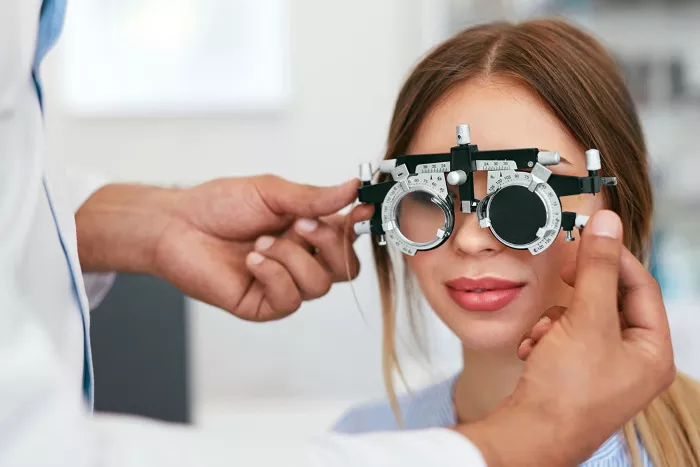Refractive eye surgery is a popular procedure to correct vision problems. It reshapes the cornea to help light focus properly on the retina. Many people choose this surgery to reduce or eliminate their need for glasses or contact lenses.
If you’re tired of blurry vision, this guide explains everything you need to know.
How Does Refractive Eye Surgery Work?
The eye works like a camera. Light enters through the cornea and lens, focusing on the retina. If the shape of the cornea isn’t perfect, light doesn’t focus correctly, causing blurry vision.
Refractive surgery fixes this by reshaping the cornea. This improves how light hits the retina, making vision clearer.
Common Types of Refractive Eye Surgery
Several types of refractive surgery exist. The best one for you depends on your eyes and lifestyle.
LASIK (Laser-Assisted In Situ Keratomileusis)
LASIK is the most well-known type. A surgeon creates a thin flap in the cornea, then uses a laser to reshape the tissue underneath. The flap is placed back, and healing is quick.
Pros:
- Fast recovery
- Minimal discomfort
- High success rate
Cons:
- Not suitable for thin corneas
- Possible dry eyes after surgery
PRK (Photorefractive Keratectomy)
PRK is an older method but still used today. Instead of creating a flap, the surgeon removes the outer layer of the cornea before reshaping it.
Pros:
- Good for thin corneas
- No risk of flap complications
Cons:
- Longer recovery
- More discomfort initially
SMILE (Small Incision Lenticule Extraction)
SMILE is a newer, less invasive option. A laser creates a small lens-shaped piece of tissue inside the cornea, which is then removed through a tiny incision.
Pros:
- No corneal flap
- Lower risk of dry eyes
- Quick procedure
Cons:
- Not for all vision problems
- Limited availability
ICL (Implantable Collamer Lens)
ICL doesn’t reshape the cornea. Instead, a thin lens is placed inside the eye, in front of the natural lens.
Pros:
- Reversible
- Good for high prescriptions
Cons:
- More invasive
- Higher cost
Who Is a Good Candidate for Refractive Surgery?
Not everyone can get refractive surgery. Here’s who might qualify:
- Stable vision prescription for at least a year
- Healthy eyes with no diseases like glaucoma or severe dry eye
- Thick enough cornea (for LASIK or PRK)
- Realistic expectations about results
Your eye doctor will perform tests to confirm if surgery is safe for you.
What to Expect Before, During, and After Surgery
Before Surgery
Your doctor will do a thorough eye exam. They’ll measure your cornea, check your prescription, and look for any issues. You may need to stop wearing contacts for a few weeks before the exam.
During Surgery
The procedure is quick, usually taking 10-30 minutes. Numbing drops keep you comfortable. You’ll be awake but won’t feel pain.
For LASIK/SMILE: You’ll stare at a light while the laser works.
For PRK: The outer corneal layer is gently removed before laser treatment.
For ICL: A small incision is made to place the lens inside the eye.
After Surgery
Recovery varies by procedure:
LASIK: Vision improves within a day; avoid rubbing your eyes.
PRK: Takes a few days to a week for vision to stabilize.
SMILE: Recovery is quick, similar to LASIK.
ICL: Vision is clear almost immediately, but follow-up visits are needed.
Your doctor will prescribe eye drops to prevent infection and reduce dryness. Avoid swimming and heavy exercise for a few weeks.
Risks and Complications
Like any surgery, refractive procedures have risks:
- Dry eyes (common but usually temporary)
- Glare or halos at night
- Undercorrection or overcorrection (may need enhancement)
- Rarely, vision loss or severe infection
Choosing an experienced surgeon reduces these risks.
How Long Do Results Last?
Most people enjoy clear vision for years. However, aging can still affect eyesight. After 40, you might need reading glasses due to presbyopia (normal age-related vision change).
Some patients need a touch-up procedure later.
Cost of Refractive Eye Surgery
Prices vary by type and location:
LASIK: 2,000to3,000 per eye
PRK: 1,800to2,500 per eye
SMILE: 2,500to3,500 per eye
ICL: 3,000to5,000 per eye
Insurance usually doesn’t cover it since it’s considered elective.
Is Refractive Surgery Worth It?
For many, the freedom from glasses or contacts is life-changing. Think about:
- Daily convenience (no more foggy glasses or lost contacts)
- Better for active lifestyles (sports, swimming)
- Long-term savings on glasses/contacts
However, it’s a personal decision. Discuss with your doctor if the benefits outweigh the risks for you.
Alternatives to Refractive Surgery
If surgery isn’t right for you, consider:
- Glasses (updated designs are lightweight and stylish)
- Contact lenses (including extended-wear options)
- Orthokeratology (special contacts worn overnight to reshape the cornea temporarily)
Conclusion
Refractive eye surgery can be a great way to improve vision. With options like LASIK, PRK, SMILE, and ICL, there’s likely a method that fits your needs.
Always consult a qualified eye surgeon to explore your options. Clearer vision could be just a procedure away!
Frequently Asked Questions
Does refractive surgery hurt?
Most patients feel little to no pain. You may feel slight pressure during the procedure.
Can both eyes be done at the same time?
Yes, most people have both eyes treated in one session.
What’s the success rate?
Over 90% of patients achieve 20/40 vision or better (good enough to drive without glasses).
How soon can I return to work?
Most return within 1-3 days, depending on the procedure.
Related topics:
7 Common Types of Retinal Surgeries
Retina Transplant for Diabetic Retinopathy: A Complete Guide
5 Top Private Cataract Surgery Options


